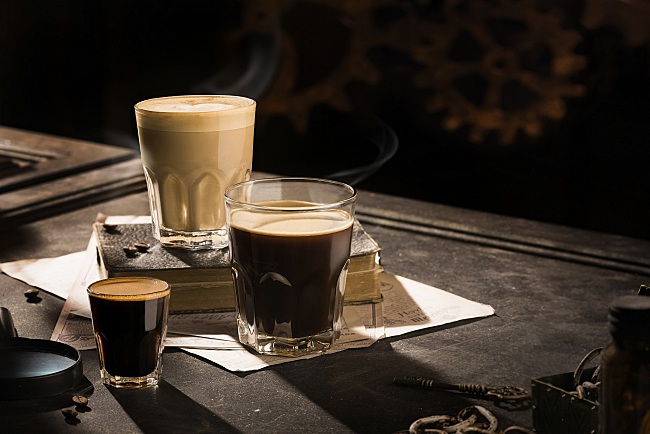Top Coffee Shops Serving SOE Single Origin Espresso Near You
Top Coffee Shops Serving SOE Single Origin Espresso Near You
Blog Article
Exploring the Rich Tastes of Coffee Beans: a Deep Study Coffee and Blended Coffee Beans
When you discover the abundant flavors of coffee beans, you uncover an intricate world where each selection brings its own character to your mug. As you browse with the art of espresso and the creative thinking behind mixed coffees, you'll begin to value the subtleties that make each sip unique.
The Origins of Coffee Beans: Exploring Terroir and Taste Profiles
When you take a sip of coffee, you're not just taking pleasure in a drink; you're experiencing an abundant tapestry of flavors formed by the beans' beginnings. Each region produces one-of-a-kind flavor accounts influenced by soil, climate, and altitude. Beans from Ethiopia frequently break with intense, fruity notes, while those from Colombia often tend to use a well balanced, nutty sweetness.
As you check out various origins, you'll notice exactly how terroir-- the ecological elements impacting a plant-- plays a crucial duty - Single Origin Espresso. The same coffee selection can taste dramatically different depending on where it's grown
When you take into consideration these factors, you begin to value the intricacy behind your cup. Each sip narrates of the land and the farmers who supported the beans. So, following time you delight, think of the trip your coffee took prior to it reached your hands, and savor those detailed flavors that reflect its beginning.
Comprehending Coffee: The Art and Scientific Research Behind the Mixture
When you consider espresso, it's not just concerning the solid taste; it's likewise regarding the methods that bring it to life. Understanding how different preparation approaches influence preference can change your developing experience. Let's check out the details of coffee prep work and discover the one-of-a-kind taste profiles that make each cup unique.
Espresso Preparation Techniques
Espresso prep work is both a scientific research and an art, incorporating specific methods with a deep understanding of coffee. To start, you'll want to choose top notch, newly roasted beans and grind them carefully for suitable extraction (Single Origin Espresso). The work dimension is crucial; also crude, and your coffee will be weak, also great, and it'll be bitter
Next, tamp the grounds evenly in the portafilter to guarantee uniform extraction. When you secure it right into the machine, aim for a developing temperature in between 190 ° F and 205 °
F.As you pull the shot, expect the ideal removal time-- around 25-30 secs. The result should be a rich, luscious espresso with a lovely layer of crema on top. With technique, you'll grasp these techniques.
Taste Profiles Explained
The world of espresso provides a rich tapestry of flavor profiles that can raise your coffee experience. Light roasts commonly display intense level of acidity and vibrant flavors, while dark roasts existing deeper, bolder tones.
Recognizing these accounts aids you pick the appropriate coffee for your taste. Trying out various blends can disclose surprising mixes. For circumstances, a well-crafted mix may balance the brilliant notes of an Ethiopian bean with the rich, chocolatey undertones of a Brazilian bean. Welcome the trip of discovering coffee's varied flavors, and you'll transform your coffee ritual right into an amazing adventure.
Handling Approaches: Exactly How They Influence Taste and Fragrance
While it may seem that the beginning of coffee beans is the most significant variable in identifying their flavor and aroma, the handling methods used post-harvest play a just as essential duty. You'll discover that these approaches can significantly alter the last taste account of your cup.
As an example, the washed procedure removes the fruit from the beans before fermentation, usually causing a cleaner, brighter flavor. Meanwhile, the all-natural process leaves the fruit intact during drying out, leading to a sweeter, fruitier profile.
Various other techniques, like honey handling, strike a balance, permitting some fruit mucilage to remain, supplying a special complexity.
Each handling strategy engages with the beans' integral attributes, boosting or muting certain tastes and scents. When you drink that espresso or mixed coffee, remember that the journey from cherry to mug is affected not just by origin but likewise by just how those beans were processed.
Roasting Strategies: Opening the Full Prospective of Coffee Beans
Roasting strategies are necessary for revealing the full capacity of coffee beans, as they change raw, environment-friendly beans into the aromatic, tasty coffee you delight in. The option of toasting approach-- light, tool, or dark-- substantially affects taste accounts. Light roasts maintain the beans' all-natural level of acidity and fruity notes, while tool roasts equilibrium sweet taste and splendor. Dark roasts, on the various other hand, emphasize bold, smoky tastes.
A slower roast at lower temperatures permits for complicated tastes to create, while a quicker roast can magnify anger. By mastering these techniques, you'll disclose a world of taste, raising your coffee experience to new elevations.
The Magic of Blended Coffee: Producing Unique Taste Experiences
Developing an one-of-a-kind taste experience with blended coffee can change your morning routine into an exploration of preference. click now By integrating various beans from different areas, you can expose a symphony of tastes that elevate your mug to brand-new heights. Each mix offers a distinct account, balancing body, sweet taste, and acidity to develop something really unique.
When you pick a blend, you're not simply selecting a coffee; you're selecting a trip throughout diverse landscapes and cultures. Trying out various mixes permits you to discover your individual faves, whether you delight in fruity notes or rich, chocolatey touches.

Sampling Notes: Recognizing the Nuances in Your Cup
As you sip your coffee, you could see a spectrum of flavors dancing on your taste buds, each disclosing the ins and outs of the beans. You may taste the intense level of acidity reminiscent of citrus or the deep, rich notes comparable to dark chocolate. The sweetness might evoke honey or caramel, stabilizing the general account beautifully.
Pay interest to the body of the coffee-- does it really feel ventilated and light, or is it full and creamy? The surface, as well, uses hints; a sticking around aftertaste might mean nuttiness or flower undertones.

Do not neglect to discover the one-of-a-kind characteristics of different beginnings, as each area presents distinct flavors - Single Origin Espresso. For instance, Ethiopian coffees often present fruity notes, while Colombian beans might showcase a more spherical sweet taste. By acknowledging these nuances, you'll grow your appreciation for each and every mug, elevating your coffee experience to brand-new elevations

Developing Methods: Optimizing Flavor Extraction for each Bean
When you check out the various developing methods, you'll uncover that each method can considerably impact the taste profile of your coffee. From French press to pour-over, each approach extracts various compounds, enhancing or silencing specific notes. For circumstances, utilizing a French press allows oils to continue to be in the brew, creating a richer taste, while pour-over stresses clearness and illumination.
Temperature level and grind size likewise play vital duties. A coarser grind functions best for cool brews, while a great official site grind is excellent for espresso. Trying out with water temperature-- in between 195 ° F and 205 ° F-- can reveal covert tastes, too.
Do not forget soaking time; a quick extraction can result in sour notes, while over-extraction might generate bitterness. By changing these variables, you can optimize taste extraction and absolutely elevate your coffee experience. Take pleasure in the trip of discovering what method finest matches your taste!
Frequently Asked Questions
What Is the Suitable Water Temperature for Developing Coffee?
The ideal water temperature for brewing coffee's in between 195 ° F and 205 ° F. If you make use of water that's also hot, you'll over-extract flavors; as well chilly, and you won't draw out sufficient. Go for that sweet spot for the finest mixture!
Just How Does Work Dimension Affect Coffee Flavor?
Grind size significantly influences coffee taste. Better grinds remove more flavors and oils, resulting in a bolder taste, while coarser grinds return a lighter taste. Readjusting work dimension aids you attain your wanted coffee account.
Exist Wellness Conveniences Linked With Alcohol Consumption Coffee?

What Is the Difference Between Arabica and Robusta Beans?
Arabica beans are smoother and sweeter, often including fruity tastes, while robusta beans are more powerful with a bitter preference and higher caffeine content. You'll see these distinctions in scent and brewing experience.
How Can I Shop Coffee Beans for Freshness?
To store coffee beans for quality, maintain them in a closed container, away from moisture, warmth, and light. If you only grind what you require right great site prior to developing., you'll maintain their flavor longer.
Discovering the Abundant Flavors of Coffee Beans: a Deep Dive Into Coffee and Blended Coffee Beans.
When you discover the abundant flavors of coffee beans, you reveal an intricate world where each variety brings its very own personality to your cup.When you take a sip of coffee, you're not just delighting in a beverage; you're experiencing a rich tapestry of tastes formed by the beans' beginnings.Roasting techniques are important for revealing the complete potential of coffee beans, as they change raw, eco-friendly beans right into the aromatic, savory coffee you take pleasure in.As you drink your coffee, you may see a spectrum of tastes dancing on your palate, each disclosing the complexities of the beans.
Report this page